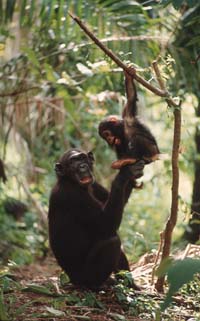Mothering and Play

Credit
Hugo van Lawick
Dr. Jane Goodall has
discovered most of the important information about the
behavior of wild chimpanzees. Dr. Goodall's study began in
1960 and continues at Gombe National Park in Tanzania
today. She has had the opportunity to watch several
generations of chimpanzee mothers and their babies and has
learned that patience and attentive care are an important
part of mothering.
Mothers allow their
daughters to help with younger brother and sisters. No
matter how "rambunctious" the child, mother is
always near to lend a helping hand - and an older brother
or sister often accompanies her.
Chimpanzee children
learn the same way human children learn. They observe the
behavior of those around them and try to duplicate it.
They also learn by doing things for themselves through
observation trial and error.
Captive Chimpanzees
Observing chimpanzee
mothers and their infants in a zoo setting allows us to
closely observe different mothering techniques. The first
thing you notice about chimpanzee mothers is their
extraordinary patience. Young chimpanzees, like human
children, just seem to love to try their mother's
patience. If you watch mother-infant pairs long enough,
you will usually discover one infant that has pushed its
mother too far - and receives a slight swat from her long,
large hand for its efforts.
When zoo chimpanzee
mothers abuse or neglect their infants, they are removed
from their care and raised by the zoo staff. Raising an
infant chimpanzee is very difficult for humans.
Hand-rearing a chimpanzee infant morally requires us to
teach them (as best we can) the things they will need to
know as socially adept adults. Therefore, we must show
them and give them opportunities to act like a chimpanzee!
We have to teach them to hang on to their surrogate mother
for travel and comfort, communicate with them using the
appropriate chimpanzee sounds and gestures, allow them
exposure to mother-reared chimpanzees to observe and
attempt to interact socially. This learning process is
critical to their development and ability to take their
place in their social group.

